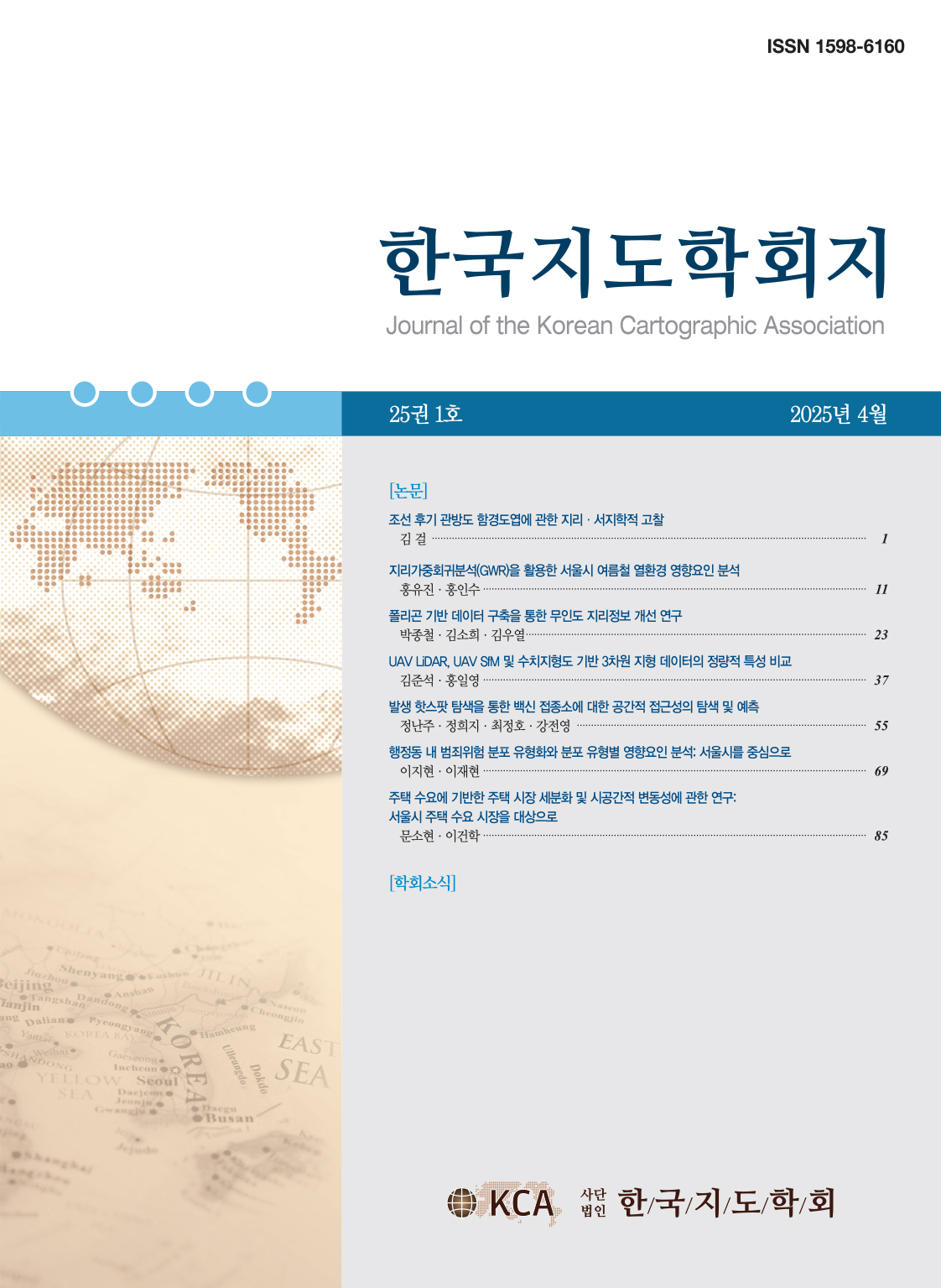Research Article
Abstract
References
Information
Walking activity is recognized as playing a crucial role in addressing urban transportation and environmental issues, enhancing public health, and revitalizing local communities. As the importance of walking gains recognition, various countries have undertaken diverse initiatives to promote pedestrian-friendly urban environments, and similar efforts are reflected in legislative and institutional frameworks in South Korea. Effective management and improvement of pedestrian environments require detailed assessments of physical walking environments at the street level, as well as an understanding of citizens' perceptions of these environments. Existing studies in this area have predominantly relied on surveys or field investigations limited to specific regions. This study aims to evaluate and compare physical and perceived pedestrian environments at the street level using street view images and deep learning technologies. For the assessment of physical pedestrian environments, evaluation indicators were selected, and data were constructed through semantic segmentation of street view images, elevation data analysis, and crawling of Points of Interest (POI) data. These data were then used to derive evaluation scores. To assess perceived pedestrian environments, a training dataset was constructed to predict perceptions from street view images, and the RSS-SWIN model was trained to estimate pedestrian environment perception scores. Comprehensive maps of physical and perceived pedestrian environments were created, and their characteristics and differences were analyzed. Based on this analysis, improvement strategies for pedestrian environments were proposed. This study is significant in its visualization and comparative analysis of physical and perceived pedestrian environments, leading to the proposal of improvement strategies. From a technical perspective, it contributes to the field by systematizing a methodology for detailed street-level pedestrian environment assessment using street view images and deep learning technologies.
보행 활동은 도시의 교통 및 환경 문제, 주민의 건강, 지역 커뮤니티 활성화 등에 중요한 역할을 하는 것으로 평가되고 있다. 보행의 중요성이 인지되면서 세계각국에서는 보행을 장려하는 도시건조환경을 만들기 위해 다양한 노력을 기울이고 있으며, 이는 우리나라에서도 법제도적으로 나타나고 있다. 보행환경을 관리하고 개선하기 위해서는 물리적인 보행환경을 가로 단위 상세수준에서 평가하고, 시민들의 보행환경에 대한 인지가 어떤지를 아는 것이 필요하다. 기존에 이러한 연구들은 대부분 설문조사나 일부지역에 한 해 현장조사를 수행하는 방법이 주를 이루었다. 본 연구에서는 거리영상과 딥러닝 기술을 활용하여 가로단위 상세수준에서의 물리적 보행환경과 인지적 보행환경을 평가하고, 이를 비교하고자 한다. 물리적 보행환경 평가를 위해 평가지표를 선정하고, 평가지표별로 거리영상의 시멘틱 세그먼테이션 기법을 활용하거나 표고 자료, PoI자료를 크롤링한 후 관련 데이터를 구축하고 평가점수를 도출하였다. 인지적 보행환경 평가를 위해 거리영상에 대한 인지를 예측할 수 있도록 훈련데이타 셋을 구축하고, RSS-Swin모델을 훈련시켜 보행환경 인지점수를 예측할 수 있도록 하였다. 물리적 보행환경과 인지적 보행환경 지도를 구축하고, 각각의 특성과 차이를 분석하고, 이를 통해 보행환경 개선안을 도출할 수 있었다. 본 연구는 물리적 보행환경과 인지적 보행환경의 시각화하고 차이를 분석하여 개선안을 도출하였다는 점에 연구의 의의가 있으며, 기술적인 측면에서는 거리영상과 딥러닝 기술을 활용하여 도시의 가로단위에서 보행환경을 상세하게 평가할 수 있는 방법론을 체계화하였다는 점에 의의가 있다.
- 강영옥, 2023, “GeoAI 활용 분야와 연구 동향,” 대한지리학회지, 58(4), 395-418. https://doi.org/10.22776/kgs.2023.58.4.39510.3917/pro.395.0058
- 강창덕, 2013, “서울시 보행 편의성 지수 측정과 정책 과제,” 서울도시연구, 14(4), 1-25.
- 경기도장애인편의증진기술지원센터, 2024, 「경기도 장애인 등의 편의시설 설치 매뉴얼」.
- 국토교통부, 2008, 「보행우선구역 표준설계매뉴얼」.
- 김소망・최재연・강영옥, 2024, ‘거리영상과 딥러닝을 활용한 가로수준의 범죄불안감 측정 및 시각화,’ 한국지도학회지, 24(1), 71-84. https://doi.org/10.16879/jkca.2024.24.1.07110.16879/jkca.2024.24.1.071
- 김은정・김명연・이지민, 2017, “대구시 레드블록 프로젝트를 통해 본 보행친화적 가로환경정비사업의 성과와 과제,” 도시행정학보, 30(3), 131-148. https://doi.org/10.36700/KRUMA.2017.09.30.3.13110.36700/KRUMA.2017.09.30.3.131
- 김지연・강영옥, 2022, “거리영상 기반 보행환경의 정성적 평가 예측을 위한 딥러닝 모델 개발,” 대한공간정보학회지, 30(2), 45-56. https://doi.org/10.7319/kogsis.2022.30.2.04510.7319/kogsis.2022.30.2.045
- 박경훈・박종완・정성관・유주한, 2007, “걷기활동 증진을 위한 보행환경 평가지표의 개발,” 한국환경과학회지, 16(11), 1231-1238.10.5322/JES.2007.16.11.1231
- 박근덕・이수기, 2018, “근린환경특성과 일상보행활동 그리고 주관적 건강수준의 구조적 관계 분석: 경로모형의 적용,” 국토계획, 53(1), 255-272. https://doi.org/10.17208/jkpa.2018.02.53.1.25510.17208/jkpa.2018.02.53.1.255
- 박소현・최이명・서한림, 2008, “도시 주거지의 물리적 보행환경요소 지표화에 관한 연구,” 대한건축학회 논문집 - 계획계, 24(1), 161-172.
- 박소현・최이명・서한림・김준형, 2009, “주거지 보행환경 인지가 생활권 보행만족도에 미치는 영향에 관한 연구,” 대한건축학회 논문집 - 계획계, 25(8), 253-261.
- 박지영・강영옥・김지연, 2022, “거리 영상과 시멘틱 세그먼테이션을 활용한 보행환경 평가 지표 개발,” 한국지도학회지, 22(1), 53-68. https://doi-org-ssl.access.ewha.ac.kr/10.16879/jkca.2022.22.1.05310.16879/jkca.2022.22.1.053
- 윤정미, 2012, “공간구문론과 GIS 통합 모델을 이용한 공간구조분석에 관한 연구 -당진시 합덕읍 일원을 대상으로-,”한국지리정보학회지, 15(3), 13-22.10.11108/kagis.2012.15.3.013
- 이경환・안건혁, 2008, “지역 주민의 보행 활동에 영향을 미치는 근린 환경 특성에 관한 실증 분석: 서울시 12개 행정동을 대상으로,” 대한건축학회 논문집 - 계획계, 24(6), 293-302.
- 이다연・이지윤・이재호, 2024, “구글 스트리트뷰와 딥러닝을 활용한 보행친화적 환경이 여가보행에 미치는 영향 평가 - 서울특별시 용산구를 대상으로 -,” 한국조경학회지, 52(4), 45-55. https://doi.org/10.9715/KILA.2024.52.4.04510.9715/KILA.2024.52.4.045
- 이병주・박상명・남궁문, 2006, “감성데이터를 이용한 보도환경의 경관평가에 관한 연구,” 대한토목학회논문집 D, 26(2D), 265-273.10.11001/jksww.2012.26.2.265
- 이수기・고준호・이기훈, 2016, “근린환경특성이 보행만족도에 미치는 영향 분석,” 국토계획, 51(1), 169-187. https://doi.org/10.17208/jkpa.2016.02.51.1.16910.17208/jkpa.2016.02.51.1.169
- 이수기・이윤성・이창관, 2014, “보행자 연령대별 보행만족도에 영향을 미치는 가로환경의 특성 분석,” 국토계획, 49(8), 91-105. https://doi.org/10.17208/jkpa.2014.12.49.8.9110.17208/jkpa.2014.12.49.8.91
- 이지윤・강영옥・김지연・박지영, 2022, “기계학습을 이용한 보행환경 정성적 평가에 영향을 미치는 거리영상 특성분석,” 한국지리학회, 11(3), 375-391. https://doi.org/10.25202/JAKG.11.3.610.25202/JAKG.11.3.6
- 최재연・김소망・강영옥, 2024a, “어디가 더 걷기 좋다고 생각하십니까? 거리영상과 샴 네트워크 기반의 딥러닝 모델을 활용한 정성적 보행환경 평가,” 한국도시지리학회지, 27(1), 65-79. https://doi.org/10.21189/JKUGS.27.1.510.21189/JKUGS.27.1.5
- 최재연・노승민・김소망・강영옥, 2024b, “거리 영상과 시멘틱 세그먼테이션을 활용한 보행환경 평가,” 대한지리학회지, 59(5), 673-687. https://doi.org/10.22776/kgs.2024.59.5.67310.22776/kgs.2024.59.5.673
- 행정안전부, 2012, 「보행안전 및 편의증진에 관한 법률」.
- 행정안전부, 2021, 「보행환경개선사업 성과평가 매뉴얼」.
- 행정안전부, 2023, 「보행안전 및 편의증진에 관한 법률(타법개정안)」.
- Asgarzadeh, M., Koga, T., Hirate, K., Farvid, M., and Lusk, A., 2014, Investigating oppressiveness and spaciousness in relation to building, trees, sky and ground surface: A study in Tokyo, Landscape & Urban Planning, 131, 36-41. https://doi.org/10.1016/j.landurbplan.2014.07.01110.1016/j.landurbplan.2014.07.011
- Bijmolt, T.H., and Wedel, M., 1995, The effects of alternative methods of collecting similarity data for multidimensional scaling, International journal of research in marketing, 12(4), 363-371. https://doi.org/10.1016/0167-8116(95)00012-710.1016/0167-8116(95)00012-7
- Blečić, I., Cecchini, A., and Trunfio, G.A., 2018, Towards automatic assessment of perceived walkability, Proceedings, Computational Science and Its Applications-ICCSA 2018: 18th International Conference, July 2-5, 2018, Melbourne, Australia, Part III 18, 351-365. https://doi.org/10.1007/978-3-319-95168-3_2410.1007/978-3-319-95168-3_24
- Burges, C., Shaked, T., Renshaw, E., Lazier, A., Deeds, M., Hamilton, N., and Hullender, G., 2005, Learning to rank using gradient descent, Proceedings, the 22nd international conference on Machine learning, August 7-11, Bonn, Germany, 89-96. https://doi.org/10.1145/1102351.110236310.1145/1102351.1102363
- Cao, X., Handy, S.L., and Mokhtarian, P.L., 2006, The influences of the built environment and residential self-selection on pedestrian behavior: evidence from Austin, TX, Transportation, 33, 1-20. https://doi.org/10.1007/s11116-005-7027-210.1007/s11116-005-7027-2
- Cao, X., Mokhtarian P.L., and Handy S.L., 2009, No particular place to go: An empirical analysis of travel for the sake of travel, Environment and Behavior, 41(2), 233-257. https://doi.org/10.1177/001391650731031810.1177/0013916507310318
- Dosovitskiy, A., Beyer, L., Kolesnikov, A., Weissenborn, D., Zhai, X., Unterthiner, T., Dehghani, M., Minderer, M., Heigold, G., Gelly, S., Uszkoreit, J., and Houlsby, N., 2021, An image is worth 16x16 words: Transformers for image recognition at scale, arXiv preprint, arXiv:2010.11929. https://doi.org/10.48550/arXiv.2010.1192910.48550/arXiv.2010.11929
- Dubey, A., Naik, N., Parikh, D., Raskar, R., and Hidalgo, C.A., 2016, Deep learning the city: Quantifying urban perception at a global scale, Proceedings, Computer Vision-ECCV 2016: 14th European Conference, October 11-14, Amsterdam, Netherlands, Part I 14, 196-212.10.1007/978-3-319-46448-0_12
- Fonseca, F., Papageorgiou, G., Tondelli, S., Ribeiro, P., Conticelli, E., Jabbari, M., and Ramos, R., 2022, Perceived walkability and respective urban determinants: Insights from Bologna and Porto, Sustainability, 14(15), 9089. https://doi.org/10.3390/su1415908910.3390/su14159089
- Frank, L.D., Schmid, T.L., Salis J.F., Chapman, J., and Saelems, B.E., 2005, Linking Objectively Measured Physical Activity with Objectively Measured Urban Form: Findings from SMARTRAQ, American Journal of Preventive Medicine, 28(2), 117-125. https://doi.org/10.1016/j.amepre.2004.11.001010.1016/j.amepre.2004.11.00115694519
- Joglekar, S., Quercia, D., Redi, M., Aiello, L., Kauer, T., and Sastry, N., 2020, FaceLift: a transparent deep learning framework to beautify urban scenes, Royal Society Open Science, 7(1), 190987. https://doi.org/10.1098/rsos.19098710.1098/rsos.19098732218934PMC7029915
- Kang, Y., Kim, J., Park, J., and Lee, J., 2023, Assessment of perceived and physical walkability using street view images and deep learning technology, ISPRS International Journal of Geo-Information, 12(5), 186. https://doi.org/10.3390/ijgi1205018610.3390/ijgi12050186
- Keall, M.D., Shaw, C., Chapman, R., and Howden-Chapman, P., 2018, Reductions in carbon dioxide emissions from an intervention to promote cycling and walking: A case study from New Zealand, Transportation research part D: Transport and environment, 65, 687-696. https://doi.org/10.1016/j.trd.2018.10.00410.1016/j.trd.2018.10.004
- Koch, G., Zemel, R., and Salakhutdinov, R., 2015, Siamese neural networks for one-shot image recognition, Proceedings, 32nd International Conference on Machine Learning deep learning workshop, Lille, France.
- Li, X. and Ratti, C., 2018, Mapping the spatial distribution of shade provision of street trees in Boston using Google Street View panoramas, Urban Forestry & Urban Greening, 31, 109-119. https://doi:10.1016/j.ufug.2018.02.01310.1016/j.ufug.2018.02.013
- Li, Y., Yabuki, N., Fukuda, T., and Zhang, J., 2020, A big data evaluation of urban street walkability using deep learning and environmental sensors a case study around Osaka University Suita campus, Proceedings, International Conference on Education and Research in Computer Aided Architectural Design in Europe, September 16-17, Berlin, Germany, 2, 319-328. https://doi.org/10.52842/conf.ecaade.2020.2.31910.52842/conf.ecaade.2020.2.319
- Liu, Z., Lin, Y., Cao, Y., Hu, H., Wei, Y., Zhang, Z., Lin, S., and Guo, B., 2021, Swin transformer: Hierarchical vision transformer using shifted windows, Proceedings, IEEE/CVF International Conference on Computer Vision (ICCV), October 11-17, Virtual, Online, 10012-10022. 10.1109/ICCV48922.2021.0098634576156PMC8471952
- Lu, Y., Sarkar, C., and Xiao, Y., 2018, The effect of street-level greenery on walking behavior: Evidence from Hong Kong, Social Science & Medicine, 208, 41-49. https://doi.org/10.1016/j.socscimed.2018.05.02210.1016/j.socscimed.2018.05.02229758477
- Mateo-Babiano, I., 2016, Pedestrian’s needs matter: Examining Manila's walking environment, Transport Policy, 45, 107-115. https://doi.org/10.1016/j.tranpol.2015.09.00810.1016/j.tranpol.2015.09.008
- Stewart, N., Brown, G.D., and Chater, N., 2005, Absolute identification by relative judgment, Psychological review, 112(4), 881-911. https://doi.org/10.1037/0033-295X.112.4.88110.1037/0033-295X.112.4.88116262472
- Wang, R., Liu, Y., Lu, Y., Yuan, Y., Zhang, J., Liu, P., and Yao, Y., 2019, The linkage between the perception of neighbourhood and physical activity in Guangzhou, China: using street view imagery with deep learning techniques. International journal of Health Geographics, 18, 18. https://doi.org/10.1186/s12942-019-0182-z10.1186/s12942-019-0182-z31345233PMC6659285
- Xie, E., Wang, W., Yu, Z., Anandkumar, A., Alvarez, J.M., and Luo, P., 2021, SegFormer: Simple and efficient design for semantic segmentation with transformers, Advances in neural information processing systems, 34, 12077-12090.
- Zhang, F., Zhou, B., Liu, L., Liu, Y., Fung, H.H., Lin, H., and Ratti, C., 2018, Measuring human perceptions of a large-scale urban region using machine learning, Landscape and Urban Planning, 180, 148-160. https://doi.org/10.1016/j.landurbplan.2018.08.02010.1016/j.landurbplan.2018.08.020
- Zhou, B., Zhao, H., Puig, X., Fidler, S., Barriuso, A., and Torralba, A., 2017, Scene parsing through ade20k dataset, Proceedings, IEEE Conference on Computer Vision and Pattern Recognition (CVPR), July 21-26, Honolulu, U.S.A., 633-641.10.1109/CVPR.2017.544PMC5505996
- Zhou, H., He, S., Cai, Y., Wang, M., and Su, S., 2019, Social inequalities in neighborhood visual walkability: Using street view imagery and deep learning technologies to facilitate healthy city planning, Sustainable Cities and Society, 50, 101605. https://doi.org/10.1016/j.scs.2019.10160510.1016/j.scs.2019.101605
- Publisher :The Korean Cartographic Association
- Publisher(Ko) :한국지도학회
- Journal Title :Journal of the Korean Cartographic Association
- Journal Title(Ko) :한국지도학회지
- Volume : 24
- No :3
- Pages :45~60
- DOI :https://doi.org/10.16879/jkca.2024.24.3.045



 Journal of the Korean Cartographic Association
Journal of the Korean Cartographic Association





